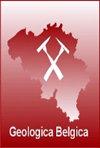波叶珊瑚,比利时上弗拉斯尼亚的一种新菲利浦珊瑚属,精确地测定了小蒙特成员的年龄
IF 0.7
4区 地球科学
Q2 GEOLOGY
引用次数: 3
摘要
1. 本工作是对比利时上弗拉斯尼亚(Upper Frasnian)的Phillipsastreidae Roemer科(1883)块状红珊瑚的修订工作的总结。Coen-Aubert(2012, 2015)对Frechastraea Scrutton, 1968的多种物种进行了详细的研究。Phillipsastrea D 'Orbigny, 1849, P. falsa Coen-Aubert, 1987和P. ranciae Coen-Aubert, 1987由Coen-Aubert(1987)描述,P. conili Tsien, 1978由科恩-奥伯特(1994)研究。本文研究了两个与Frechastraea相似的拟珊瑚类物种,但有较大的珊瑚,它们以前被归为Phillipsastrea,但在此将其归为新属Potyphyllum,这是基于Cyathophyllum ananas Goldfuss, 1826作为模式种。大多数比利时出现的紫叶菊和P. veserense(科恩-奥伯特,1974年)的特征是上棕榈牙形带。正如Coen-Aubert(2012, 2015)所提到的,泥盆纪地层学小组委员会(Subcommission on Devonian Stratigraphy)已将上弗拉斯纪的基底固定在牙形石Palmatolepis semi - ovae的入口处。在比利时,在Lower Palmatolepis rhenana区域内观察到P. semichatovae的进入,以及anyrognathus triangularis的首次出现,而2012年大量的rugose珊瑚Frechastraea coeni Coen-Aubert可以被认为是Upper Frasnian基地的优秀标志。正如科恩-奥伯特(Coen-Aubert, 2015)所解释的那样,那慕尔盆地的表达式为本文章由计算机程序翻译,如有差异,请以英文原文为准。
Potyphyllum, a new phillipsastreid genus of rugose corals in the Upper Frasnian of Belgium with precisions about the age of the Petit-Mont Member
1. IntroductionThis work serves as conclusion for the revision of massive rugose corals belonging to the family Phillipsastreidae Roemer, 1883 and occurring in the Upper Frasnian of Belgium. The diverse species of Frechastraea Scrutton, 1968 have been investigated in detail by Coen-Aubert (2012, 2015). As for Phillipsastrea D’Orbigny, 1849, P. falsa Coen-Aubert, 1987 and P. ranciae Coen-Aubert, 1987 were described by Coen-Aubert (1987) and P. conili Tsien, 1978 was studied by Coen-Aubert (1994). The present paper is concerned with two pseudocerioid species like Frechastraea, but with larger corallites, which have been previously ascribed to Phillipsastrea, but which are herein assigned to the new genus Potyphyllum based on Cyathophyllum ananas Goldfuss, 1826 as type species. Most Belgian occurrences of Potyphyllum ananas and P. veserense (Coen-Aubert, 1974) characterize the Upper Palmatolepis rhenana conodont Zone. As mentioned by Coen-Aubert (2012, 2015), the base of the Upper Frasnian has been fixed by the Subcommission on Devonian Stratigraphy, at the entry of the conodont Palmatolepis semichatovae. In Belgium, the entry of P. semichatovae is observed within the Lower Palmatolepis rhenana Zone, together with the first occurrence of Ancyrognathus triangularis whereas the massive rugose coral Frechastraea coeni Coen-Aubert, 2012 can be considered as an excellent marker for the base of the Upper Frasnian. As it is explained by Coen-Aubert (2015), the expression Namur Basin is
求助全文
通过发布文献求助,成功后即可免费获取论文全文。
去求助
来源期刊

Geologica Belgica
地学-地质学
CiteScore
4.70
自引率
27.80%
发文量
8
审稿时长
>12 weeks
期刊介绍:
Geologica Belgica is a Belgian journal that welcomes papers concerning all aspects of the earth sciences, with a particular emphasis on the regional geology of Belgium, North West Europe and central Africa. Papers not dedicated to the geology of Belgium, North West Europe and central Africa are only accepted when one of the authors is linked to a Belgian University or Institution. Thematic issues are highly appreciated. In this case, guest editors take in charge the selection of the manuscripts and the subject of the papers can be enlarged. The journal is in open access.
Submitted manuscripts should be concise, presenting material not previously published. The journal also encourages the publication of papers from Belgian junior authors. Short letters are accepted. Papers written in English are preferred. Each mansucript will be reviewed by at least two reviewers.
 求助内容:
求助内容: 应助结果提醒方式:
应助结果提醒方式:


